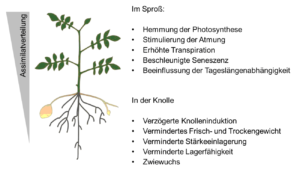Plant-Biochemistry and Biotechnology – Group Uwe Sonnewald
The research group concentrates on application-oriented basic science in the field of plant growth and development as well as aspects of synthetic biology. Plant growth is depended on internal and external factors and it has been proposed that climate change represents the major challenge for food production in the near future. Therefore, we analyze the molecular basis of plant adaptations to periods of heat and drought to make them resilient to climate change. To increase productivity of crop plants such as potato and cassava we use biotechnology to improve assimilate production, allocation and utilization. In synthetic biology we apply targeted protein-protein interactions to reprogram plant metabolism to be better adapted to future climate conditions. One focus of this work is the use of sequence specific, intermolecular isopeptide bridges, which allows the design of artificial protein complexes in in vitro and in plant cells ( doi: 10.1186/s13007-020-00663-9 ; doi: 10.1371/journal.pone.0179740 ).
Adaptation to climate change:
According to independent climate models, global temperature will increase and distribution of annual rain falls will change. However, little is known about plant responses to combined heat and drought stress. In case of potato a moderate rise in temperature has already profound effects. Potato is the third most important food crop in the world after rice and wheat. Because of its widely distributed cultivation and high yields, it is considered a critical species in terms of food security in face of a growing world population. However, potato is particularly vulnerable to high temperature during various stages of its life cycle. Elevated temperatures strongly suppress tuberisation, negatively affect storage and shelf life of tubers and reduce fitness of seed potatoes. Breeding new heat-stress tolerant cultivars is an urgent need for sustainable increases in potato production, given the negative impact of the rises in temperature due to global warming.
To unravel the molecular background of the temperature- and drought-dependent decline in potato yield, different potato varieties are tested within national and international research projects under field and controlled greenhouse conditions. By combining genotyping by sequencing with molecular, biochemical, physiological and agronomical phenotyping yield-relevant genome regions are predicted and validated. This allows a comparison between genotypes and identification of mechanisms which are causally linked to heat- and/or drought-tolerance. Identified processes, genes or alleles can be exploited by conventional breeding and/or biotechnology. Beside this unbiased approach, processes known to be important for yield and resilience are addressed directly. According to current data, elevated temperatures cause a reduction in the expression of the tuber-inducing FT-homologous protein called SP6A (Self-Pruning 6A) and consequently reduced tuber yield ( doi: 10.1111/pce.13366 ). SP6A belongs to the phosphatidylethanolamine-binding proteins (PEBP) and has been shown to inhibit apoplasmic sucrose efflux from the transport phloem by binding and inhibiting activity of SWEET efflux carrier ( doi: 10.1016/j.cub.2019.02.018 ). Inhibition of sucrose efflux supports long distance sucrose transport to developing tubers and has been speculated to be important for tuberization. Ongoing research aims at elucidating the molecular details of SP6A action and regulation. In this context, a small regulatory RNA (SES) could be shown as a novel regulatory of SP6A expression. SES is heat inducible and binds to its target SP6A mRNA. SES binding results in the posttranscriptional degradation of SP6A mRNA and hence inhibition of tuberization ( doi: 10.1016/j.cub.2019.04.027 ). By specifically addressing SP6A or SES expression, potato genotypes with improved stress tolerance can be designed. To achieve this goal breeding and biotechnological approaches including genome editing and transgenesis are applied. Similar to the analysis of heat tolerance, we follow molecular strategies to improve drought tolerance of potato genotypes. These strategies include attempts to reduce water loss by reducing transpiration and approaches to improve water uptake by enhancing root growth. By combining guard cell-specific expression of hexokinase and SP6A expression, transgenic potato plants being more hat and drought tolerant under greenhouse conditions could be generated. These promising results provide the scientific basis for more in-depth studies and hopefully lead to the design of climate adapted potato genotypes.
Improving source-sink relations in crop plants:
Distribution of photoassimilates, mainly fixed during photosynthesis in source leaves, to harvestable plant organs is the most important determinant of crop yield. Allocation of photoassimilates is affected by environmental and endogenous factors. In several crop plants temperature and day length significantly determine the switch between vegetative and generative growth. In potato for instance, elevated temperatures promote shoot growth and at the same time inhibits tuber-induction, leading to a reduced tuber yield. Similarly, biotic stress often alters source-to-sink relations to support growth of the invading pathogen. This is achieved by reprogramming primary carbon metabolism and leads to a reduced photoassimilate supply of developing sink tissues. Source-to-sink interactions are not static but change during development. In young growing plants the rate of photosynthesis often exceeds sink demand. Thus photoassimilates accumulate in leaves and reduce photosynthetic efficiency (sink inhibition of photosynthesis). After flowering or induction of vegetative sink tissues (such as roots or tubers), this relation shifts and photoassimilate supply to developing sink tissues can get limiting (source limitation). Over the last decades, many factors influencing source-to-sink relations have been deciphered and this knowledge has been used to design transgenic plants with improved biomass production and yield. In frame of two international research projects ( www.photoboost.org ; cass-research.org ) we try to specifically alter the interaction between leaves and storage roots of cassava plants and leaves and tubers of potato plants to increase yield of both crop plants. Here we simultaneously improve leaf (Source) transport (phloem) and root/tuber (Sink) metabolism. The scientific concept of the cassava project has been published in Sonnewald et al., 2020 ( doi: 10.1111/tpj.14865 ). General ideas to improve source-sink relations and crop yield are discussed in Fernie et al., 2020 ( doi: 10.1038/s41477-020-0590-x ).

